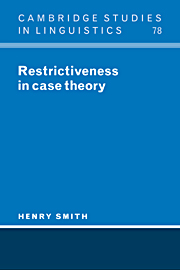8 - Conclusions
Published online by Cambridge University Press: 04 November 2009
Summary
In order to put the preceding proposals into perspective, some concluding remarks on the nature of linking theory are in order. What I have proposed is a theory both of how certain surface properties are related to each other and of how these relate to the wide array of properties associated with grammatical functions, the results of linking on our system. The theory derives grammatical functions largely on a basis that is closely related to surface form. The theory must be tested language by language, and cumulatively, to see whether it handles surface and grammatical function facts well and, most importantly, simultaneously.
First, it is important to keep in mind what the consequences of distinguishing morphological and syntactic case are. Most theories make this distinction one way or another. Something in the theory will be distinct both from morphological case and argument structure. As we have argued, distinguishing grammatical functions from morphological case is one such tool but one which does not put much of a constraint on the relation of morphology to argument structure.
Direct linking opposes linkers to morphological case and to argument structure. Different morphological cases may not be instantiations of the same linker, but we do allow the same case to reflect different linkers, different syntactic cases. Once we have allowed this, though, one might object that the analysis of a given language is by no means unique. How can we tell if two instances of dative reflect different linkers – different syntactic datives, two rules – or not?
As a preliminary matter, it should be remembered that the same problem arises on conventional grammatical function- or structural position-based approaches.
- Type
- Chapter
- Information
- Restrictiveness in Case Theory , pp. 289 - 292Publisher: Cambridge University PressPrint publication year: 1996



